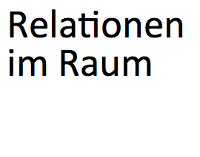Breadcrumb
- Collaborate
- Partner projects
- Frühere Partnerprojekte
ehemalige-partnerprojekte
Former Partner Projects
A list of former partner projects.
3D-JoinsThe interdisciplinary research and development project "3D Joins und Schriftmetrologie" developed sustainable concepts and methods for the collection of character specififications depicted on fragmented cuneiform tablets, their assorting along quantitative characteristics and finally a 3D reconstruction of the individual cuneiform tablets. |
|
SaDAThe goal of the project "SaDA - Semi-automatic Difference Analysis of Complex Text Variants" was the elaboration of sub-processes of philological work for the filiation of transmission variants of a text and for the reconstruction of the text genesis with the existence of a multitude of variants, which can be supported by information technology methods and tools. |
|
|
| Relations in spaceRelations in space analyses and visualises spatial relations between tombs of Jewish cemeteries from nine centuries (11th-20th centuries). On the basis of concrete research questions and in an exchange between the participating cultural scientists and computer scientists, a "topography visualizer" will be developed that will enable the analysis of a wide variety of cemetery ensembles. |
 | Poznan Home of German JewsThe German-Polish cooperation project funded by the BKM investigates how tradition, cohesion, self-perception and interest in the "homeland of Poznan" developed among the German Jews who emigrated from the province of Poznan after the Polish state had reemerged. In particular, the project focuses on the "Poznan Heimatblätter" as a primary source. The georeferenced bibliography of the contributions is visualized in the DARIAH Geobrowser. The binational team also uses the DARIAH Wiki and Etherpad for contemporary collaborative collaboration across borders. |
DASISHDASISH (Data service infrastructure for the social sciences and humanities) had been a cluster project that brought together all five ESFRI research infrastructure initiatives in the social sciences and humanities: CLARIN - Common Language Resource and Technology Infrastructure; DARIAH - Digital Research Infrastructure for the Arts and Humanities; CESSDA - Consortium of European Social Science Data Archives; ESS - European Social Survey and SHARE - Survey of Health, Aging and Retirement in Europe. The aim of the project had been to identify possible synergies in the development of infrastructures and work together on selected activities. | |
Digital Humanities Research GroupThe research group "Digital Humanities" had been a joint project of the faculties and institutions of the University of Göttingen, the Max Planck Society, the Academy of Sciences of Göttingen and the Herzog August Bibliothek Wolfenbüttel, which had been integrated in the Göttingen Center for Digital Humanities (GCDH). The interdisciplinary cooperation aimed at innovative computer- and internet-related research questions and methods in the social sciences and humanities. The successful work of the research group has lead, among other things, to the establishment of a Digital Humanities Professorship at the Department of Computer Science at the University of Göttingen. | |
EHRIThe EHRI project unites the heterogeneous sources of the Holocaust distributed to different archives in Europe and beyond and builds a uniform Holocaust research area. These include the establishment of coordinated physical access facilities, a virtual research space with comprehensive access to all relevant research data, as well as research on authoritative standards and interoperability mechanisms. | |
NeDIMAHThe NeDiMAH project (Network for Digital Methods in the Arts and Humanities) was funded by the European Science Foundation from 2011-2015. As its objectives, the project defined the creation of a map that visualizes the use of digital research in Europe, an ontology of digital research methods and a collaborative and interactive online platform for the European research community. The project results can be found in the brochure Beyond the Digital Humanities. | |
Networked correspondencesThe "Networked Correspondences - Research and visualization of social, spatial, temporal, and thematic networks in correspondence" centered around the correspondences of German-speaking writers who had been exiled under the national socialists. By employing DH methods, the letters should be crosslinked, indexed and intelligently tagged to ultimately visualizs entire correspondences and theme networks. | |
SlaVaCompBased on the example of the Greek-church-linguistic translations and church-linguistic original texts in Eastern and South-Eastern Europe, exemplary diachronic and regional differentiations of the language Kirchenslavisch (church slavonic) were investigated. The project used analysis tools (church slavonic tools in TextGrid). Also an index and a bilingual online dictionary for the study of graphical and lexical variability of church slavonic in its temporal and spatial development were prepared. | |
TextGrid Implementation of SharedCanvasThe SharedCanvas data model has been developed by the Stanford University Library, Los Alamos National Library, and the OpenAnnotation Collaboration (with the support of the Mellon Foundation). The SharedCanvas partner libraries consist among others of the British Library, the Bibliothèque Nationale de France and the Johns Hopkins Library in the USA. The TextGrid repository has been made compatible with SharedCanvas tools. This allows SharedCanvas users to access content from the TextGrid repository in order to work with it. The tools developed by SharedCanvas have been integrated into TextGrid. The implementation extended the user community of TextGrid by making repository content available to SharedCanvas users and partner institutions while providing TextGrid users with access to SharedCanvas compatible content from other institutions. | |
| | Universal-KirchenzeitungFor the development, analysis and digital edition of the "Universal Church Newspaper for the Clergy and the Educated World Class of Protestant, Catholic and Israelite Germany" as a subproject of the "German-Jewish Journalism of the 19th Century" (Steinheim Institute / DISS), various DARIAH-DE tools such as Geobrowser and Digivoy were used. |

